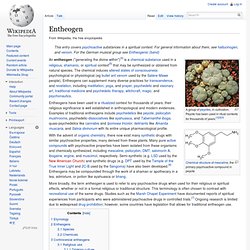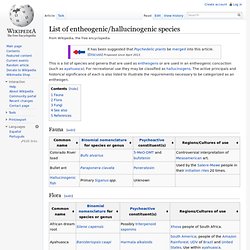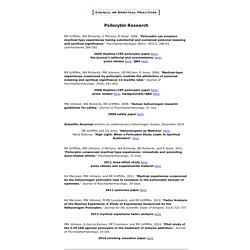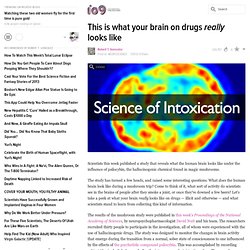

Psychedelic Research Around the World. Animals on Psychedelics: Survival of the Trippiest. There's a recent article in the Pharmaceutical Journal by Andrew Haynes that talks about the widespread use of psychedelics in the animal kingdom. Haynes' argument for explaining this behavior rests on the idea of boredom-—literally bored animals are seeking pharmacological stimulation, much in the same way that bored humans seek pharmaceutical stimulation—but there might be something else going on. Since I cover this same topic in my latest book, "A Small Furry Prayer," rather than try to rewrite the material, I'm offering the following excerpt as a deeper explanation for the origins of the phenomena: "In his 1983 book, From Chocolate to Morphine, University of Arizona physician Andrew Weil points out that children spin in circles to change their consciousness, while adults do the same thing with booze and drugs .
So instinctive does this behavior appear that, Weil suspected, perhaps humans aren't the first species to actively pursue altered states . Psychedelic Research Papers. Entheogen. A group of peyotes, in cultivation.

Peyote has been used in ritual contexts for thousands of years.[1][2][3] With the advent of organic chemistry, there now exist many synthetic drugs with similar psychoactive properties, many derived from these plants. Many pure active compounds with psychoactive properties have been isolated from these organisms and chemically synthesized, including mescaline, psilocybin, DMT, salvinorin A, ibogaine, ergine, and muscimol, respectively. Semi-synthetic (e.g. LSD used by the New American Church) and synthetic drugs (e.g. Etymology[edit] List of psychedelic plants. List of entheogens. This is a list of species and genera that are used as entheogens or are used in an entheogenic concoction (such as ayahuasca).

For recreational use they may be classified as hallucinogens. The active principals and historical significance of each is also listed to illustrate the requirements necessary to be categorized as an entheogen. Fauna[edit] Flora[edit] Fungi[edit] See also[edit] References[edit] Project MKULTRA. Declassified MKUltra documents Project MKUltra — sometimes referred to as the CIA's mind control program — was the code name given to an illegal and clandestine program of experiments on human subjects, designed and undertaken by the U.S.

Central Intelligence Agency (CIA). Experiments on humans were intended to identify and develop drugs and procedures to be used in interrogations and torture, in order to weaken the individual to force confessions through mind control. Organized through the Scientific Intelligence Division of the Central Intelligence Agency (CIA), the project coordinated with the Special Operations Division of the U.S. Concerned with "the research and development of chemical, biological, and radiological materials capable of employment in clandestine operations to control human behavior. " Project MKUltra was first brought to public attention in 1975 by the Church Committee of the U.S. Background[edit] Dr. Precursor experiments[edit] MKUltra[edit] Goals[edit] Drugs[edit] The Free-energy Principle. Council on Spiritual Practices - Hopkins/CSP Psilocybin Research. Psilocybin Research RR Griffiths, WA Richards, U McCann, R Jesse. 2006.

"Psilocybin can occasion mystical-type experiences having substantial and sustained personal meaning and spiritual significance. " Psychopharmacology (Berl). 187(3), 268-83, commentaries 284-292. 2006 Hopkins/CSP psilocybin paper here; the journal's editorial and commentaries here; press release here; Q&A here. RR Griffiths, WA Richards, MW Johnson, UD McCann, R Jesse. 2008. 2008 Hopkins/CSP psilocybin paper here; press release here; backgrounder/Q&A here. MW Johnson, WA Richards, RR Griffiths. 2008. 2008 safety paper here. Scientific American articles on contemporary hallucinogen studies, December 2010 RR Griffiths and CS Grob, "Hallucinogens as Medicine" here; Maria Estevez, "High Light: When a Psilocybin Study Leads to Spiritual Realization" here. This is what your brain on drugs really looks like. This actually raises several questions... 1.

Where did they get the drugs to begin with? And how do you go about getting "permission" from the government (which I assume they had) to conduct these experiments? I can't fathom it's easy to get shrooms in Britain (since Nutt is British and works at a British university, I assume that's where he conducted the experiments). 2. 10 Scientific and Technological Visionaries Who Experimented With Drugs. Same here.

We evolved along with, and because of, our diet. There weren't any classifications of "illegal drugs" back then, and these things flourish in all sorts of conditions in the wild - it's hard not to imagine at least occasional consumption. Considering mankind's predilection to experimenting with consciousness, along with the unique effects of these substances (including euphoria), it was probably more than occasional. If these fungi were part of a diet over time, they'd likely have some effect on our development. At the very least, to assume that these type of natural and prolific plants/substances had no part in our evolution would seem foolish. I just love the idea of psychoactive botanicals spurring hominid consciousness to a higher quantum state — the booster shot needed to make that leap forward in intelligence.
SExpand Exactly!